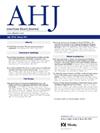2型糖尿病和炎性关节炎患者的心律失常风险:SGLT2抑制剂与GLP-1受体激动剂的比较分析
IF 3.5
2区 医学
Q1 CARDIAC & CARDIOVASCULAR SYSTEMS
引用次数: 0
摘要
背景:SGLT2抑制剂和GLP-1受体激动剂均已证实对2型糖尿病(T2D)的心血管有益,但它们在合并炎性多关节病患者的心律失常发生率比较尚不清楚。本研究旨在评估这两种药物在这一特定患者群体中发生心律失常的风险差异。方法在这项使用TriNetX全球联合健康研究网络的回顾性队列研究中,我们确定了患有T2D和炎性多关节病的成年患者,他们开始使用SGLT2抑制剂(n=3,278)或GLP-1受体激动剂(n=4,612)。经过倾向评分匹配(每组2838例),我们比较了5年随访期间各种心律失常的发生率,包括房颤、室性心动过速、室颤、病态窦性综合征和起搏器植入需求。结果与接受GLP-1受体激动剂治疗的患者相比,接受SGLT2抑制剂治疗的患者房颤(10.4% vs 7.8%, HR 1.552, 95% CI 1.303-1.848, p<0.001)和室性心动过速(4.8% vs 2.2%, HR 2.467, 95% CI 1.825-3.334, p<0.001)的发生率显著高于接受GLP-1受体激动剂治疗的患者。心室颤动在SGLT2抑制剂组中也更为常见(2.4% vs 0.8%, HR 3.451, 95% CI 2.131-5.590, p<0.001)。SGLT2抑制剂使用者的窦病综合征发生率更高(1.0% vs 0.7%),但差异无统计学意义。SGLT2抑制剂组的起搏器植入率更高(5.1% vs 3.9%, HR 1.466, 95% CI 1.144-1.878, p=0.002)。结论在t2dm和炎性多关节病患者中,与SGLT2抑制剂相比,GLP-1受体激动剂治疗与重大心律失常的风险显著降低相关。这些发现表明,GLP-1受体激动剂可能是T2D和炎症性关节炎患者心律失常风险增加的首选。需要进一步的研究来阐明这些差异背后的机制。本文章由计算机程序翻译,如有差异,请以英文原文为准。
Comparative Analysis of Arrhythmia Risk: SGLT2 inhibitors versus GLP-1 Receptor Agonists in Patients with Type 2 Diabetes and Inflammatory Arthritis
Background
Both SGLT2 inhibitors and GLP-1 receptor agonists have demonstrated cardiovascular benefits in type 2 diabetes (T2D), but their comparative arrhythmogenic profiles in patients with comorbid inflammatory polyarthropathy remain unclear. This study aimed to evaluate the differential risk of cardiac arrhythmias between these two drug classes in this specific patient population.
Methods
In this retrospective cohort study using the TriNetX global federated health research network, we identified adult patients with T2D and inflammatory polyarthropathy who were initiated on either SGLT2 inhibitors (n=3,278) or GLP-1 receptor agonists (n=4,612). After propensity score matching (n=2,838 per group), we compared the incidence of various arrhythmias including atrial fibrillation, ventricular tachycardia, ventricular fibrillation, sick sinus syndrome, and need for pacemaker implantation over a 5-year follow-up period.
Results
Patients treated with SGLT2 inhibitors demonstrated significantly higher rates of atrial fibrillation (10.4% vs 7.8%, HR 1.552, 95% CI 1.303-1.848, p<0.001) and ventricular tachycardia (4.8% vs 2.2%, HR 2.467, 95% CI 1.825-3.334, p<0.001) compared to those receiving GLP-1 receptor agonists. Ventricular fibrillation was also more common in the SGLT2 inhibitor group (2.4% vs 0.8%, HR 3.451, 95% CI 2.131-5.590, p<0.001). Sick sinus syndrome occurred more frequently in SGLT2 inhibitor users (1.0% vs 0.7%), though this difference was not statistically significant. Pacemaker implantation rates were higher in the SGLT2 inhibitor cohort (5.1% vs 3.9%, HR 1.466, 95% CI 1.144-1.878, p=0.002).
Conclusion
Among patients with T2D and inflammatory polyarthropathy, treatment with GLP-1 receptor agonists was associated with significantly lower risk of major cardiac arrhythmias compared to SGLT2 inhibitors. These findings suggest that GLP-1 receptor agonists may represent a preferred option for patients with T2D and inflammatory arthritis who are at increased risk for cardiac arrhythmias. Further investigation is warranted to elucidate the mechanisms underlying these differences.
求助全文
通过发布文献求助,成功后即可免费获取论文全文。
去求助
来源期刊

American heart journal
医学-心血管系统
CiteScore
8.20
自引率
2.10%
发文量
214
审稿时长
38 days
期刊介绍:
The American Heart Journal will consider for publication suitable articles on topics pertaining to the broad discipline of cardiovascular disease. Our goal is to provide the reader primary investigation, scholarly review, and opinion concerning the practice of cardiovascular medicine. We especially encourage submission of 3 types of reports that are not frequently seen in cardiovascular journals: negative clinical studies, reports on study designs, and studies involving the organization of medical care. The Journal does not accept individual case reports or original articles involving bench laboratory or animal research.
 求助内容:
求助内容: 应助结果提醒方式:
应助结果提醒方式:


